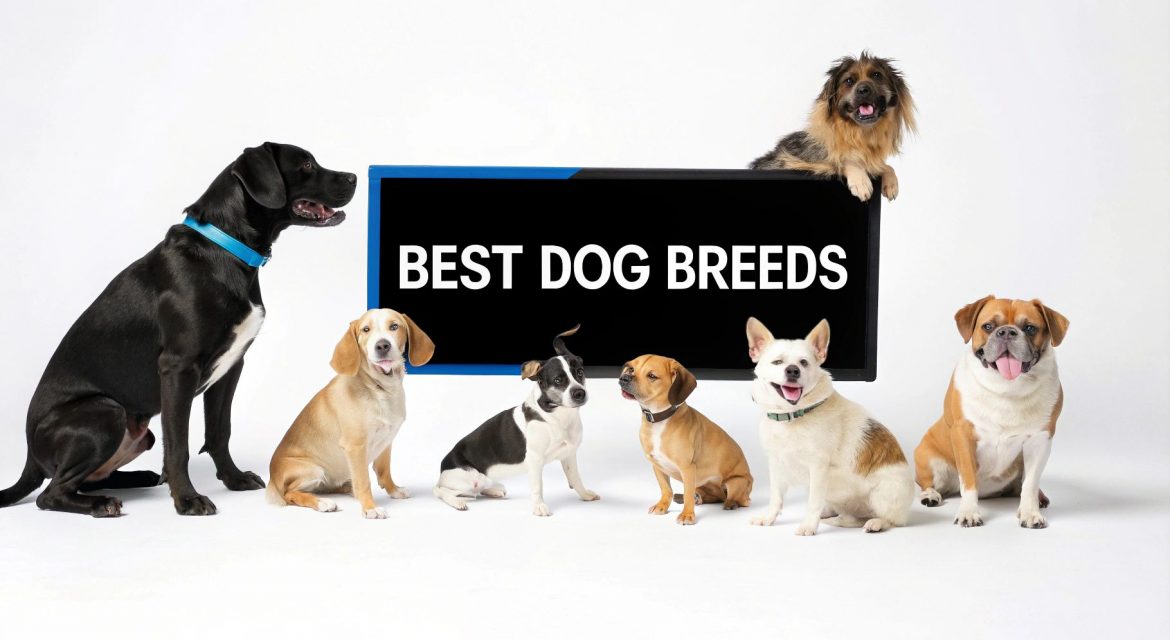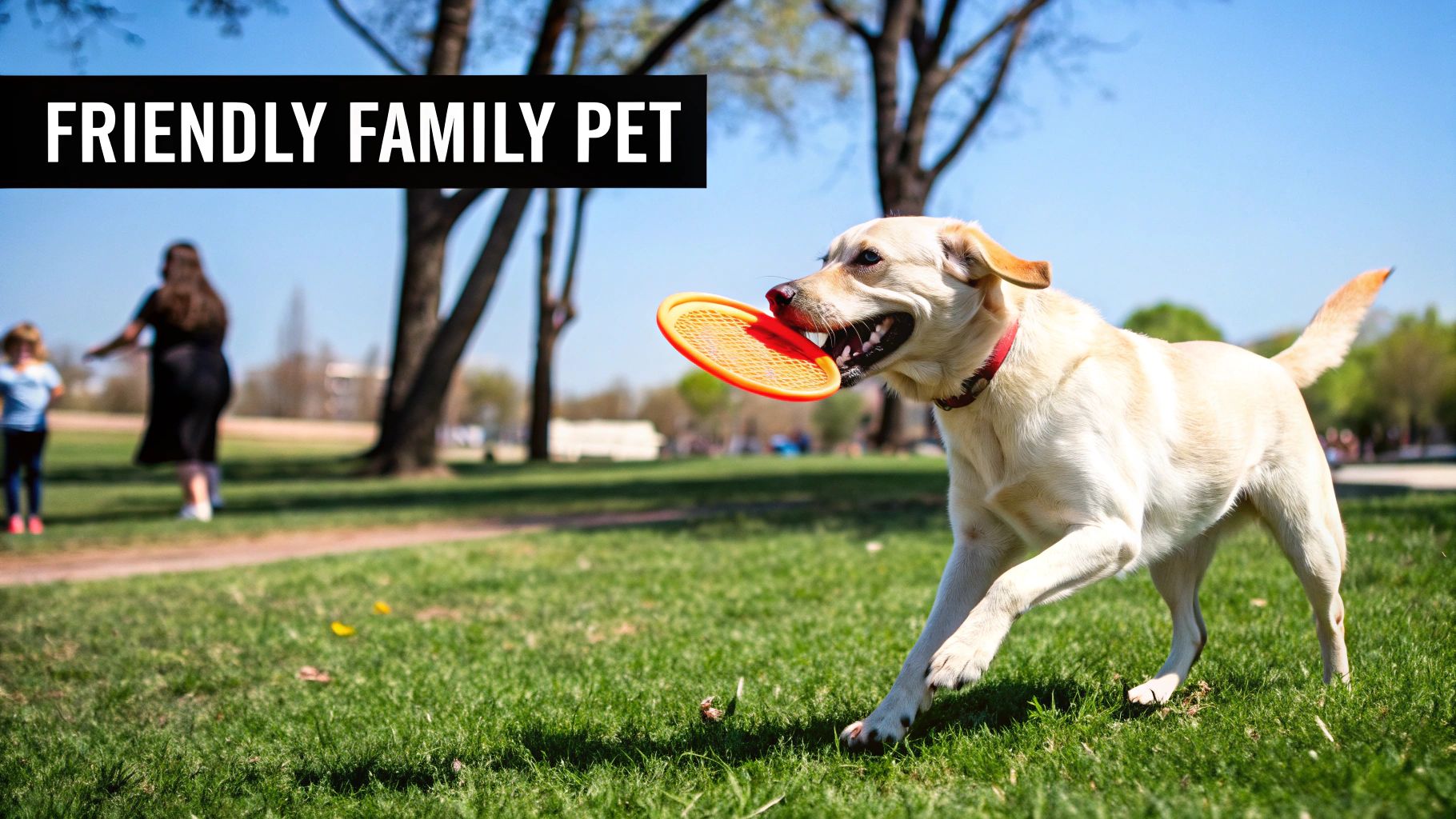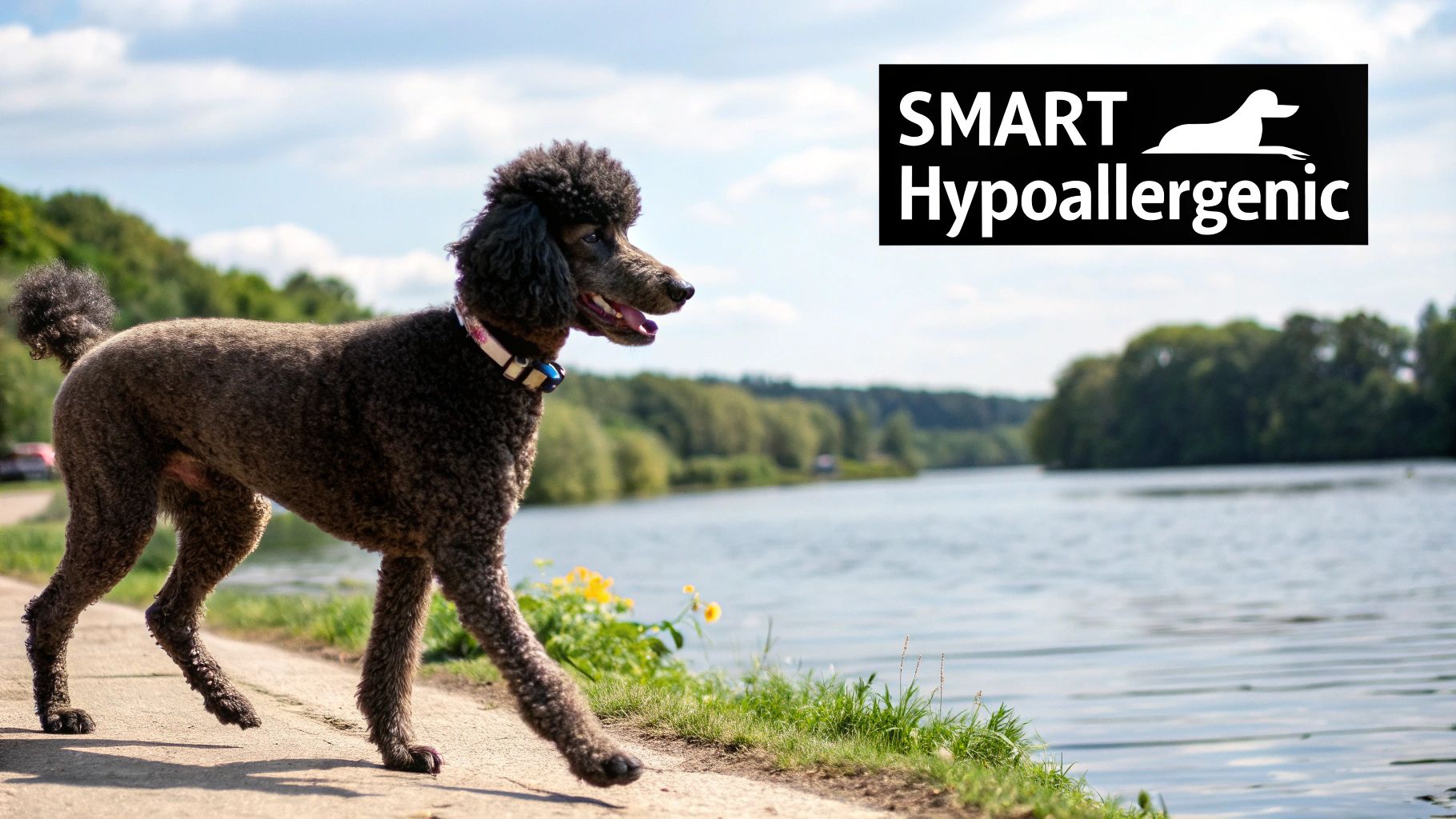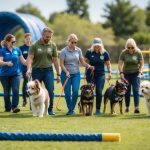Bringing a dog into your life is one of the most rewarding experiences you can have. That wagging tail greeting you at the door, the unconditional love, and the shared adventures create a special kind of magic. But if you’re a first-time owner, we know the thought of choosing the right companion can feel a little overwhelming. You're not just picking a pet; you're choosing a new family member, and it's completely understandable to want to get it right.
You're looking for a friend who will be patient as you learn the ropes, a dog whose needs realistically match your lifestyle, and a companion who will grow with you. The ideal first dog often has a forgiving nature, a moderate energy level, and an eagerness to please, making the training process smoother and more enjoyable for both of you. Getting this choice right sets the foundation for a lifetime of happiness together.
That's why we've put together this detailed guide to the best dog breeds for beginners. We're here to walk you through each one, sharing the real-life details – the joys, the quirks, and the practicalities – to help you make a choice that feels right for you and your home. We'll explore everything from their temperament and grooming needs to their exercise requirements and trainability. Think of us as a friendly guide, holding your hand as you start this exciting new journey. Let's find the furry friend you've been dreaming of.
1. The Golden Retriever: The Quintessential Family Friend
If you close your eyes and picture the perfect family dog, there's a strong chance a Golden Retriever comes to mind. This isn't a coincidence; they are genuinely one of the most reliable and beginner-friendly breeds out there, celebrated for their seemingly endless patience, gentle temperament, and sharp intelligence. For a first-time owner like you, their forgiving nature is a huge asset. They seem to understand that you're learning too, which makes training feel less like a daunting task and more like a joyful bonding activity we can all appreciate.
Originally bred in the Scottish Highlands during the 1860s by Lord Tweedmouth to retrieve game, their inherent desire to please has made them a beloved companion worldwide. Their profound loyalty means they connect deeply with every member of the family, from the youngest child to the eldest grandparent. This adaptable and loving nature is why they are so often chosen as therapy and assistance dogs, a true testament to their stable and trustworthy character.
Understanding the Golden Retriever's Needs
While their temperament is famously easy-going, a happy Golden Retriever is one whose needs are met. They are an active and intelligent breed, and it’s important we provide both physical exercise and mental stimulation for them to thrive. Without this, they can become bored and may develop undesirable behaviours like chewing or excessive barking.
- Exercise: Plan for at least 60-90 minutes of activity every day. This can include brisk walks, a jog in the park, or enthusiastic games of fetch in your garden.
- Training: Begin training as soon as you bring them home. Their intelligence and eagerness to please mean they respond exceptionally well to positive reinforcement methods like praise, treats, and clicker training.
- Grooming: Their beautiful double coat requires regular attention. You'll want to brush them two to three times a week to manage shedding (which can be significant) and prevent their fur from matting.
- Socialisation: To nurture their famously friendly disposition, it's vital to socialise them early and often. Introduce your puppy to a wide variety of people, vaccinated dogs, and different environments in a positive, controlled way.
Key Insight: A Golden Retriever's forgiving nature makes them one of the best dog breeds for beginners. They are patient with inexperienced handlers, turning your training mistakes into learning opportunities rather than setbacks.
Breed Characteristics at a Glance
To better understand their needs, the following chart breaks down key breed characteristics, rated on a scale of one to five.
This data highlights that while Goldens excel in friendliness and trainability, their high energy and grooming needs are important considerations for any potential owner. For a more in-depth look at their history and care, you can explore our complete Golden Retriever breed profile.
2. The Labrador Retriever: The All-Round Enthusiast
It's no surprise that the Labrador Retriever has consistently been one of the world's most popular dog breeds for decades. Their reputation as a devoted, cheerful, and highly adaptable companion is thoroughly deserved. For a novice owner, a Labrador offers a perfect blend of high intelligence and a forgiving, good-natured spirit. They are energetic and playful, bringing a sense of joy and adventure to any household, yet they are also deeply loyal and eager to please, which simplifies the training process for you considerably.
Originating from Newfoundland, where they assisted fishermen by retrieving nets and stray fish from the icy waters, the Labrador's work ethic and friendly demeanour were refined in the UK by nobles like the Earl of Malmesbury. This background shaped them into the resilient and trainable dogs we know today. Their stable temperament makes them a superb choice not only for families but also for critical roles such as guide dogs, search and rescue operatives, and therapy animals. They form strong bonds with all family members and greet life with an infectious enthusiasm that is hard to resist.
Understanding the Labrador Retriever's Needs
A Labrador's famously happy disposition is directly tied to having their needs met. As a working breed, they possess a significant amount of energy and intelligence that requires a proper outlet. A bored Labrador can easily become a destructive one, so keeping them physically and mentally engaged is the key to a harmonious home for you both.
- Exercise: A Labrador needs at least 90-120 minutes of vigorous activity each day. You can split this into walks, runs, swimming, or extended games of fetch. Their stamina is considerable.
- Training: Start positive reinforcement training early. Labradors are food-motivated and quick learners, making them highly responsive to reward-based methods. Consistency is crucial, especially with leash training, so you can manage their natural strength and tendency to pull.
- Grooming: Their short, dense double coat is relatively low-maintenance but does shed. A good brush once or twice a week will help you manage loose hair and keep their coat healthy.
- Socialisation: Early and ongoing socialisation is vital to channel their outgoing nature appropriately. Exposing your Labrador puppy to various sights, sounds, people, and other dogs will help them grow into a well-adjusted and confident adult.
Key Insight: A Labrador's combination of high intelligence and an eagerness to please makes them exceptionally trainable. For beginners like you, this means your efforts in training are likely to be rewarded quickly, building your confidence as a new dog owner.
Breed Characteristics at a Glance
To better understand their needs, the following chart breaks down key breed characteristics, rated on a scale of one to five.
This data highlights that while Labradors are top-tier in friendliness and trainability, their very high energy levels are a critical factor. They are not suited for a sedentary lifestyle and thrive in an active home. For more detailed information, you can explore our complete Labrador Retriever breed profile.
3. The Cavalier King Charles Spaniel: An Elegant and Affectionate Companion
If you're seeking a companion dog that embodies grace, affection, and a wonderfully gentle spirit, the Cavalier King Charles Spaniel is an exceptional choice. This toy breed perfectly balances the loving nature of a lap dog with the lively heart of a sporting spaniel, making them one of the best dog breeds for beginners who want a smaller, manageable friend. Their sweet, expressive eyes and unwavering devotion have charmed families and royalty for centuries, including their namesake, King Charles II.
Steeped in aristocratic history and famously featured in royal portraits, these dogs were bred to be the ultimate companions. Their primary job is to love and be loved, a role they fill with enthusiasm. For a first-time owner, their desire to please and adaptable nature are invaluable. They are content with a quiet life at home but equally happy to join you on gentle adventures, fitting seamlessly into various lifestyles, from living with a single person to being part of a bustling family.
Understanding the Cavalier King Charles Spaniel's Needs
While their temperament is famously agreeable, ensuring a Cavalier is happy means understanding their specific needs as a companion breed. They thrive on human interaction and do not do well if left alone for extended periods. Their gentle nature requires a similarly gentle approach to their care and training, something we know you'll be great at.
- Exercise: A moderate amount of daily activity is sufficient. Aim for a couple of short, leisurely walks and some indoor playtime each day to keep them healthy and content.
- Training: Cavaliers are intelligent and eager to please, making them responsive to training. Use positive reinforcement with gentle guidance; they are sensitive and do not respond well to harsh methods.
- Grooming: Their silky, medium-length coat is beautiful but prone to matting. A thorough brushing two to three times a week is necessary to keep their fur in good condition and manage shedding.
- Health: This breed can be predisposed to certain health conditions, particularly heart issues like Mitral Valve Disease (MVD). Regular veterinary check-ups for heart monitoring are crucial for their long-term wellbeing.
- Socialisation: Early and consistent socialisation is key to nurturing their friendly demeanour. Introduce them to various people and calm, vaccinated dogs to ensure they grow into well-rounded and confident adults.
Key Insight: The Cavalier's defining trait is their deep need for companionship. They are true "Velcro dogs" that flourish when they are an integral part of their family's daily life, making them unsuitable for homes where they would be left alone frequently.
Breed Characteristics at a Glance
To better understand if this breed is the right fit for you, the following chart breaks down their key characteristics, rated on a scale of one to five.
This data shows that while Cavaliers excel as low-energy, highly affectionate companions, their grooming and potential health needs are important factors. Their friendly nature has also made them a popular parent breed for sought-after crosses; you can explore our profile on the Cavapoo to learn more.
4. Poodle (Standard): The Elegant Intellect
Don't let the Poodle's sophisticated, show-ring haircut fool you; beneath that elegant exterior lies a whip-smart, athletic, and surprisingly playful companion. The Standard Poodle is an exceptional choice for first-time owners, combining high intelligence with a profound desire to please, which makes the training process intuitive and rewarding for you. Their goofy sense of humour and loving nature often surprise those who only know them by their prim reputation. For a novice owner, their trainability is a significant advantage, as they pick up on commands and household rules with remarkable speed.
Originally bred in Germany as tenacious water retrievers (the name "Poodle" comes from the German word pudel, meaning "to splash in water"), their intelligence and athleticism were honed for work, not just for looks. This working background means they form a strong, loyal bond with their families and thrive on being part of your daily activities. Their hypoallergenic coat, which sheds very little, is another major draw for beginners, particularly those of us with allergies. Their versatility has also made them popular in the creation of many mixed breeds, and you can explore various Poodle crossbreeds to see how their wonderful traits are shared.
Understanding the Poodle's Needs
While their temperament is adaptable, a Poodle’s brilliant mind and athletic body require consistent engagement to stay happy and well-behaved. If we neglect their need for stimulation, it can lead to boredom and mischief, so it's vital to provide outlets for both their physical and mental energy.
- Exercise: Aim for at least 60 minutes of varied exercise each day. This should include brisk walks or jogs, but also activities they love, like swimming or games of fetch.
- Training: Their sharp intellect means they need mental workouts just as much as physical ones. Use positive reinforcement and keep training sessions fun and engaging. They excel in dog sports like agility and obedience, which are great ways to challenge their minds.
- Grooming: Their non-shedding coat comes with a trade-off: it grows continuously and requires significant upkeep. You'll need to brush them daily to prevent mats and schedule professional grooming appointments every 4-6 weeks.
- Socialisation: Early socialisation is key to ensuring your Poodle grows into a confident, well-adjusted adult. Introduce them calmly to new sights, sounds, people, and other dogs from a young age to build their social skills.
Key Insight: A Standard Poodle's intelligence makes them one of the best dog breeds for beginners who are eager to engage in training. They learn quickly, turning the often-challenging puppy phase into an enjoyable and collaborative experience for you both.
Breed Characteristics at a Glance
To better understand their needs, the following chart breaks down key breed characteristics, rated on a scale of one to five.
This data highlights that while Poodles are top-tier in trainability and are great for allergy sufferers, their high grooming and mental stimulation needs are crucial factors for any new owner to consider.
5. The Bichon Frise: The Cheerful Powder Puff
If you're looking for a dog that embodies pure joy in a small, fluffy package, the Bichon Frise is an outstanding choice. These charming little dogs, with their cloud-like white coats and endlessly cheerful dispositions, are perfectly suited for first-time owners. Their playful, affectionate, and intelligent nature makes them a delight to have around, and their small size is ideal for those of us living in apartments or smaller homes. For a beginner, their manageable needs and loving personality provide a wonderful introduction to dog ownership.
Originating in the Mediterranean, the Bichon Frise was adored by European royalty during the Renaissance and later found fame as a clever circus performer. This history has shaped a breed that is not only beautiful but also highly trainable and eager to be the centre of attention. Their primary purpose has always been companionship, so they form incredibly strong bonds with their families and thrive on human interaction, making them one of the best dog breeds for beginners seeking a constant, loving friend.
Understanding the Bichon Frise's Needs
While their temperament is generally easy-going, a Bichon Frise needs consistent care to keep them happy and healthy. Their intelligence means they require mental engagement, and their famous coat demands regular maintenance to stay in its pristine, powder-puff condition. We know you can handle it!
- Exercise: A daily walk of around 30 minutes, combined with indoor play sessions, is typically sufficient to meet their energy needs. They enjoy short bursts of activity and love games that engage their clever minds.
- Training: Begin positive reinforcement training early. Bichons are smart and eager to please, but can sometimes be tricky to house-train. A consistent schedule and crate training on your part are vital for success.
- Grooming: This is a significant commitment. Their hypoallergenic coat, which sheds very little, must be brushed daily to prevent painful mats and tangles. Professional grooming every four to six weeks is also necessary.
- Socialisation: Early and frequent socialisation is key to nurturing their friendly nature. Introduce your Bichon puppy to various people, vaccinated dogs, and new situations to build their confidence and prevent shyness.
Key Insight: The Bichon Frise is a fantastic companion for those of us with allergies. Their low-shedding, hypoallergenic coat makes them a more manageable option for sensitive individuals, but this benefit comes with a non-negotiable daily grooming requirement.
Breed Characteristics at a Glance
To better understand their needs, the following chart breaks down key breed characteristics, rated on a scale of one to five.
This data shows that while their friendliness and trainability are top-tier, the grooming commitment is a crucial factor for any prospective owner to consider. For a more detailed look at their history and care, you can explore our complete Bichon Frise breed profile.
6. The Brittany: The Enthusiastic and Agile Companion
For the active beginner looking for a canine partner who can keep up with their adventures, the Brittany is an exceptional choice. This medium-sized sporting dog, originating from the Brittany province of France, packs the energy of a larger dog into a more compact and manageable frame. Their keen intelligence and profound desire to please make them one of the most trainable breeds, a huge bonus for a first-time owner like you.
Formerly known as the Brittany Spaniel, their name was officially shortened to reflect their distinct, pointer-like hunting style. This heritage gives them a spirited and good-natured temperament, always ready for action and deeply devoted to their human family. They possess a sensitivity that helps them connect with their owners on a deep level, making training a collaborative and rewarding experience rather than a chore. Their gentle disposition and joyful outlook make them a fantastic addition to an active household.
Understanding the Brittany's Needs
A Brittany's cheerful nature is directly linked to having their physical and mental needs met. They are a high-energy breed, originally developed for long days in the field, and require a significant outlet for their stamina. Without sufficient stimulation, a bored Brittany can become anxious and may resort to destructive habits, so we want to make sure they're engaged.
- Exercise: A Brittany needs at least 60-90 minutes of vigorous exercise every day. This goes beyond a simple walk; they thrive on activities like running, hiking, and intensive games of fetch.
- Training: Their intelligence is a double-edged sword. They learn incredibly quickly, which is fantastic for beginners, but they also need consistent, engaging training to keep their sharp minds occupied. Positive reinforcement is the key to unlocking their potential.
- Grooming: Their single coat is relatively low-maintenance compared to other sporting breeds. A weekly brushing is usually enough to remove loose hair and prevent tangles, with more frequent sessions during seasonal shedding.
- Socialisation: Early and consistent socialisation is crucial. Exposing your Brittany puppy to various sights, sounds, people, and other dogs will help mould their naturally friendly demeanour into that of a confident, well-adjusted adult dog.
Key Insight: The Brittany is an ideal choice for a beginner who leads an active lifestyle. Their combination of high intelligence, eagerness to please, and manageable size makes them a trainable and adaptable companion, provided you can meet their substantial exercise needs.
7. The Papillon: The Elegant and Brainy Companion
Don't let the Papillon's delicate, butterfly-like ears and dainty appearance fool you; this is a robust and surprisingly athletic dog packed into a tiny frame. The name "Papillon" is French for butterfly, a nod to their most distinctive feature. For the beginner owner seeking a small companion with a big brain and an even bigger heart, the Papillon is an exceptional choice. They blend the convenience of a toy breed with the intelligence and eagerness to learn of a much larger working dog.
Steeped in European history, Papillons were favoured companions of nobility and were often featured in portraits by masters like Rubens, a testament to their long-standing appeal. Their historical role as charming lap dogs has evolved, and today they excel in modern dog sports, proving they are far more than just a pretty face. This combination of intelligence, trainability, and affectionate nature makes them one of the most manageable and rewarding small dog breeds for beginners.
Understanding the Papillon's Needs
While their small size makes them adaptable to various living situations, including apartment life, a Papillon requires consistent engagement to be truly happy. Their sharp mind needs a job to do, and they thrive on interaction and training with their human family. If we neglect their need for stimulation, it can lead to nuisance barking or other signs of boredom.
- Exercise: Despite their size, they are energetic. You should aim for at least 30 minutes of activity each day, which can include brisk walks, indoor games of fetch, or learning new tricks.
- Training: Begin positive reinforcement training early. Papillons are highly intelligent and learn quickly, making them stars in obedience and agility. Their desire to please you makes training a delightful experience rather than a chore.
- Grooming: Their long, silky coat is surprisingly low-maintenance as it lacks an undercoat. Brushing two to three times a week is usually sufficient to prevent tangles and mats and to keep them looking their best.
- Socialisation: Early and positive socialisation is key to building their confidence. Introduce your Papillon puppy to different people, well-behaved dogs, and new environments to ensure they grow into a well-adjusted and friendly adult.
Key Insight: The Papillon's high intelligence and trainability make them stand out amongst toy breeds. For a first-time owner like you, this means you get the portability of a small dog without sacrificing the joy of training a clever and responsive canine partner.
Breed Characteristics at a Glance
To better understand if this breed fits your lifestyle, the following chart breaks down their key characteristics, rated on a scale of one to five.
This data shows that while Papillons are top-tier in terms of friendliness and ease of training, their energy levels and need for mental engagement are important factors to consider. For a more detailed look into their care and history, you can explore our complete Papillon breed profile.
Top 7 Beginner-Friendly Dog Breeds Comparison
| Breed | Implementation Complexity 🔄 | Resource Requirements ⚡ | Expected Outcomes 📊 | Ideal Use Cases 💡 | Key Advantages ⭐ |
|---|---|---|---|---|---|
| Golden Retriever | Moderate – training and exercise needed | High – daily exercise, regular grooming | Loyal, obedient family companion | Families with children, therapy/service dogs | Friendly, versatile, highly trainable |
| Labrador Retriever | Moderate – needs consistent training | Moderate – vigorous exercise, weekly grooming | Friendly, adaptable, reliable | Guide dogs, search & rescue, family pets | Social, intelligent, generally healthy |
| Cavalier King Charles Spaniel | Low to moderate – gentle training | Moderate – regular grooming | Gentle, adaptable companion | Apartment living, elderly owners, therapy dogs | Small, elegant, good for apartments |
| Standard Poodle | High – requires mental & physical stimulation | High – daily exercise + professional grooming | Intelligent, hypoallergenic family dog | Allergy sufferers, dog sports, service dogs | Hypoallergenic, very smart, versatile |
| Bichon Frise | Moderate – consistent training required | High – frequent professional grooming | Friendly, social, long-lived | Apartment dwellers, therapy dogs | Hypoallergenic, cheerful, sociable |
| Brittany | Moderate to high – high energy & focus | Moderate – vigorous exercise, occasional baths | Energetic, trainable sporting dog | Active families, hunters, dog sports | Athletic, intelligent, good for outdoors |
| Papillon | Low to moderate – training for behavior | Moderate – regular brushing and dental care | Intelligent, small and adaptable | Apartment living, obedience, therapy | Highly trainable, small, long lifespan |
Your Next Steps on This Wonderful Journey
Choosing your first canine companion is a monumental decision, one that blends logic with love, and practicalities with pure excitement. We've journeyed through a curated list of some of the best dog breeds for beginners, from the ever-sunny Golden Retriever to the clever and elegant Papillon. Our goal was to give you a clear, honest picture of what life with each of these wonderful breeds might look like, empowering you to move forward with confidence.
The most crucial takeaway is that while breed tendencies provide an excellent starting point, every dog is an individual. We know that a breed’s reputation for being placid or energetic is a helpful guide, but the real magic happens when you match a specific dog's personality and needs with your own lifestyle and capacity for care. This journey is less about finding a "perfect" breed and more about finding the perfect partner for your unique life.
From Research to Reality: Your Actionable Checklist
Feeling inspired? That's fantastic! But before you bring home your furry new family member, let’s channel that excitement into proactive, thoughtful preparation. This is where you transform from a prospective owner into a prepared one.
Here are your concrete next steps to ensure a smooth and joyful transition into dog ownership:
- Honest Lifestyle Audit: Re-evaluate your daily routine. How many hours are you truly at home? How much time can you realistically dedicate to walks, play, and training each day? Be brutally honest with yourself. This self-assessment is the single most important factor in choosing the right dog for you.
- Budgeting for a Furry Friend: Beyond the initial adoption or purchase fee, let's map out the ongoing costs. Factor in high-quality food, vet check-ups, vaccinations, potential emergency care, grooming appointments, toys, and training classes. Creating a detailed budget now prevents financial stress later.
- Connect with the Community: Theory is great, but real-world experience is invaluable. We suggest you seek out breed-specific owner groups on social media or local meet-up clubs. Ask current owners about the day-to-day realities. What do they wish they had known? What are the biggest joys and challenges? Their insights are pure gold.
- Explore Ethical Sources: Now is the time to research reputable sources.
- Breeders: Look for Kennel Club Assured Breeders or those who willingly show you their facilities, introduce you to the puppy's parents, and provide comprehensive health clearances for the parent dogs. A responsible breeder will ask you as many questions as you ask them.
- Rescue Centres: Visit local shelters and breed-specific rescues online. Speak to the staff about their dogs. They have intimate knowledge of each animal's history, temperament, and needs, and are experts at making a successful match. Don't discount a wonderful cross-breed who might just tick all your boxes!
Key Insight: The perfect dog for a beginner isn't just about the breed; it's about the support system you build. Preparing your home, your finances, and your schedule before the dog arrives is the foundation of a successful and loving relationship.
Embracing this preparation phase doesn't diminish the excitement; it deepens it. You are not just getting a pet; you are thoughtfully and responsibly preparing to welcome a new life into your home. This process ensures that when your dog finally crosses the threshold, you are ready to be the leader, friend, and companion they deserve. This is the start of an incredible adventure, filled with unconditional love, muddy paws, and unforgettable memories. Welcome to the wonderful world of dog ownership!
Ready to take the next step with confidence? At My Life My Dog, we provide personalised guidance, training resources, and community support tailored for new owners just like you. Let us help you build an incredible bond from day one by visiting us at My Life My Dog.







